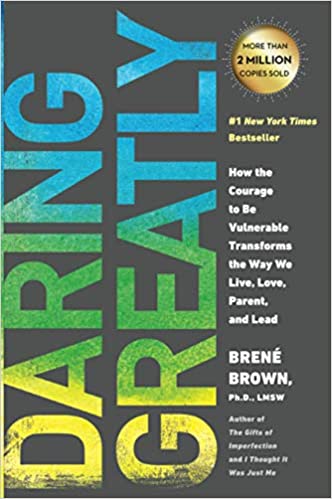Love is a powerful force that has captivated and mystified humanity for centuries. It’s that inexplicable feeling that can make your heart race, your palms sweat, and your mind go into overdrive. But what exactly happens in our bodies when we fall in love? The answer lies in the fascinating world of chemistry.
When you’re in love, a cascade of chemical reactions takes place in your brain and body, shaping your emotions and influencing your behavior. From the release of dopamine that brings about feelings of pleasure and reward, to the surge of oxytocin that deepens the bond between two individuals, love is truly a chemical cocktail. Join us on a journey into the science of love, as we uncover the secrets behind the chemical reactions that occur when we’re smitten.
Get ready to be amazed by the intricate workings of the human brain and how they contribute to the enchanting experience of being in love.

Daring Greatly
by Brene Brown
⏱ 13 minutes reading time
🎧 Audio version available
The chemistry behind love: neurotransmitters and hormones
Love is not just an abstract concept; it has a physical basis in our bodies. The chemical reactions that occur when we’re in love are driven by neurotransmitters and hormones. These chemical messengers play a crucial role in shaping our emotions and behaviors.
Dopamine: the pleasure chemical
One of the key players in the chemistry of love is dopamine. Dopamine is a neurotransmitter that is associated with pleasure and reward. When we’re in love, our brain releases dopamine, which leads to feelings of euphoria and happiness.
This surge of dopamine is responsible for the intense pleasure we experience when we’re with our loved one or even just thinking about them. It’s what makes us feel like we’re floating on cloud nine.
Serotonin: the mood stabilizer
Another important neurotransmitter involved in the chemistry of love is serotonin. Serotonin helps regulate our mood and emotions. When we’re in love, serotonin levels can fluctuate, leading to a rollercoaster of emotions.
This explains why we might feel elated one moment and then suddenly experience anxiety or even jealousy. The fluctuation in serotonin levels is also responsible for the obsessive thoughts and constant thinking about our loved one that can occur when we’re smitten.
Oxytocin: the bonding hormone
Oxytocin is often referred to as the “love hormone” or “cuddle hormone.” It plays a crucial role in deepening the bond between two individuals. When we’re in love, our brain releases oxytocin, which creates a sense of trust, intimacy, and bonding.
This hormone is particularly important in romantic relationships and is responsible for the strong emotional connection and attachment we feel towards our partner. Oxytocin is also released during physical touch, such as hugging or kissing, further strengthening the bond between two people.
Endorphins: the feel-good chemicals
Endorphins are natural painkillers produced by our bodies. They are responsible for the feelings of pleasure and well-being that we experience when we’re in love.
When we’re smitten, our brain releases endorphins, which help reduce stress, boost our mood, and create a sense of happiness. These feel-good chemicals contribute to the overall euphoria and excitement that accompanies being in love.
The role of adrenaline in love
Love can sometimes feel like a rollercoaster ride, with its ups and downs, twists and turns. This emotional rollercoaster is partly due to the release of adrenaline, also known as the “fight or flight” hormone.
When we’re in love, our body goes into a heightened state of arousal, and adrenaline is released, leading to increased heart rate, sweaty palms, and a rush of energy. This adrenaline rush can make us feel alive and exhilarated, adding to the intensity of our emotions when we’re in love.
Love at first sight: the role of pheromones
Love at first sight has long been a subject of fascination and intrigue. It turns out that pheromones, chemical substances secreted by our bodies, play a role in this phenomenon. Pheromones are odorless chemical signals that can influence our behavior and attraction towards others.
When we’re attracted to someone, our body may release pheromones that can subconsciously signal our interest to the other person. While the role of pheromones in human attraction is still being studied, they are believed to play a part in the initial stages of falling in love.
The science behind heartbreak: cortisol and stress
Love is not always a bed of roses; it can also bring heartbreak and emotional pain. When we experience heartbreak, our body goes into a stress response, triggering the release of cortisol, the primary stress hormone.
Cortisol can lead to feelings of anxiety, sadness, and even physical pain. This explains why heartbreak can feel so physically and emotionally draining. The chemistry of heartbreak is a stark reminder that love and its chemical reactions can have both positive and negative effects on our well-being.
Love and the brain: the impact on brain activity and structure
Love has a profound impact on our brain activity and structure. When we’re in love, certain areas of our brain light up, indicating increased neural activity. These areas include the pleasure centers, reward centers, and areas associated with social bonding and attachment.
Over time, being in love can actually change the structure of our brain, reinforcing the neural pathways associated with love and attachment. This rewiring of the brain is what makes love such a powerful and transformative experience.
Love and long-term relationships: the importance of attachment
In long-term relationships, love goes beyond the initial stages of infatuation. Attachment becomes a crucial component of love, and this is governed by the hormone oxytocin. Oxytocin promotes feelings of trust, bonding, and attachment, which are essential for maintaining a strong and fulfilling relationship.
It’s what makes us feel secure and connected to our partner. The chemistry of love in long-term relationships involves a delicate interplay between dopamine, serotonin, and oxytocin, ensuring that the bond between two individuals remains strong and enduring.
Love and physical attraction: the role of evolution
Physical attraction is often the first spark that ignites love. From an evolutionary perspective, physical attraction plays a vital role in mate selection and reproduction. When we’re physically attracted to someone, our brain releases dopamine, creating feelings of pleasure and reward.
This attraction is driven by a combination of genetic and environmental factors, as well as societal influences. The chemistry of physical attraction is a complex interplay between our genetic makeup, personal preferences, and cultural norms.
Love and personal preferences: the influence of genetics
Have you ever wondered why you’re attracted to certain types of people? The answer may lie in your genetics. Studies have shown that our genetic makeup can influence our personal preferences when it comes to love and attraction. Certain genes are associated with traits such as empathy, kindness, and humor, which are often desirable qualities in a partner.
Genetic compatibility can also play a role in the chemistry of love, as our bodies subconsciously seek out partners who have different immune system genes, increasing the chances of healthy offspring.
Related: What Are The 5 Love Languages And How To Transform Your Love Life
The science of love and happiness
Love has a profound impact on our overall happiness and well-being. When we’re in love, our brain releases a cocktail of chemicals that create feelings of pleasure, reward, and happiness. These chemicals, including dopamine, oxytocin, and endorphins, contribute to our overall sense of well-being and contentment.
Love has been shown to improve our mental and physical health, boost our immune system, and even increase our lifespan. The science of love and happiness highlights the profound connections between our emotional and physical well-being.
Conclusion: understanding the chemical reactions of love
Love is a complex and enchanting experience that is deeply rooted in the chemistry of our bodies. When we’re in love, a series of chemical reactions takes place, shaping our emotions and influencing our behavior. From the release of dopamine that brings about feelings of pleasure and reward, to the surge of oxytocin that deepens the bond between two individuals, the chemistry of love is a fascinating and intricate process.
Understanding the chemical reactions of love not only allows us to appreciate the profound beauty of this experience but also sheds light on the intricate workings of the human brain and the complex interplay between our biology, emotions, and relationships. So the next time you’re in love, remember that it’s not just a matter of the heart but also a matter of chemistry.
What Is Snapreads?

With the Snapreads app, you get the key insights from the best nonfiction books in minutes, not hours or days. Our experts transform these books into quick, memorable, easy-to-understand insights you can read when you have the time or listen to them on the go.
